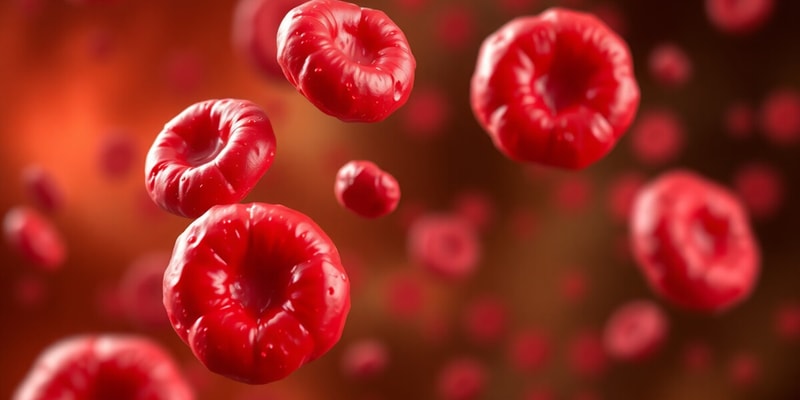Podcast
Questions and Answers
What is the primary distinguishing feature of an orthchromatic normoblast?
What is the primary distinguishing feature of an orthchromatic normoblast?
What characterizes a mature red cell or erythrocyte?
What characterizes a mature red cell or erythrocyte?
What is the primary concern in anemia?
What is the primary concern in anemia?
Which of the following is NOT a symptom of anemia?
Which of the following is NOT a symptom of anemia?
Signup and view all the answers
Why is skin examination considered subjective when evaluating pallor?
Why is skin examination considered subjective when evaluating pallor?
Signup and view all the answers
What is the common manifestation attributed to decreased oxygen supply in anemia?
What is the common manifestation attributed to decreased oxygen supply in anemia?
Signup and view all the answers
Which finding is considered the most consistent indicator of anemia?
Which finding is considered the most consistent indicator of anemia?
Signup and view all the answers
Anemia is defined as a reduction in which of the following?
Anemia is defined as a reduction in which of the following?
Signup and view all the answers
What color mixture characterizes the early stages of certain red blood cells?
What color mixture characterizes the early stages of certain red blood cells?
Signup and view all the answers
Which symptom can also be seen in conditions unrelated to anemia?
Which symptom can also be seen in conditions unrelated to anemia?
Signup and view all the answers
What happens once the liver takes over hematopoiesis?
What happens once the liver takes over hematopoiesis?
Signup and view all the answers
Which type of cell develops into macrophages?
Which type of cell develops into macrophages?
Signup and view all the answers
Which cytokine is involved in the production of myelocytes?
Which cytokine is involved in the production of myelocytes?
Signup and view all the answers
What role does Erythropoietin (EPO) play in hematopoiesis?
What role does Erythropoietin (EPO) play in hematopoiesis?
Signup and view all the answers
Which cells are pluripotent stem cells controlled by?
Which cells are pluripotent stem cells controlled by?
Signup and view all the answers
Basophils develop into which type of cell?
Basophils develop into which type of cell?
Signup and view all the answers
Which cells are directly stimulated by cytokine IL-3 during hematopoiesis?
Which cells are directly stimulated by cytokine IL-3 during hematopoiesis?
Signup and view all the answers
Which of the following represents cells that are lost in the hematopoietic system?
Which of the following represents cells that are lost in the hematopoietic system?
Signup and view all the answers
What is the developmental outcome of B-lymphocytes in the system?
What is the developmental outcome of B-lymphocytes in the system?
Signup and view all the answers
Which stimulating control is primarily involved in myelocyte production?
Which stimulating control is primarily involved in myelocyte production?
Signup and view all the answers
What stimulates the kidney to produce EPO after an injury?
What stimulates the kidney to produce EPO after an injury?
Signup and view all the answers
What is the time frame for reticulocyte production after stimulation by EPO?
What is the time frame for reticulocyte production after stimulation by EPO?
Signup and view all the answers
What condition can lead to hypochromic/microcytic anemia due to chronic blood loss?
What condition can lead to hypochromic/microcytic anemia due to chronic blood loss?
Signup and view all the answers
Which mechanism occurs during intravascular hemolysis?
Which mechanism occurs during intravascular hemolysis?
Signup and view all the answers
What is a result of increased hemoglobin catabolism?
What is a result of increased hemoglobin catabolism?
Signup and view all the answers
What often causes hidden or occult blood loss in elderly patients?
What often causes hidden or occult blood loss in elderly patients?
Signup and view all the answers
What does Mean Corpuscular Volume (MCV) determine?
What does Mean Corpuscular Volume (MCV) determine?
Signup and view all the answers
Mean Corpuscular Hemoglobin Concentration (MCHC) is used to assess which aspect of red blood cells?
Mean Corpuscular Hemoglobin Concentration (MCHC) is used to assess which aspect of red blood cells?
Signup and view all the answers
What condition is characterized by a deficiency in iron in hemoglobin?
What condition is characterized by a deficiency in iron in hemoglobin?
Signup and view all the answers
Which type of anemia results from a failure to incorporate iron into hemoglobin?
Which type of anemia results from a failure to incorporate iron into hemoglobin?
Signup and view all the answers
In the case of thalassemia, what type of defect is present?
In the case of thalassemia, what type of defect is present?
Signup and view all the answers
What does increased Mean Corpuscular Volume (MCV) and Mean Corpuscular Hemoglobin (MCH) alongside normal MCHC usually indicate?
What does increased Mean Corpuscular Volume (MCV) and Mean Corpuscular Hemoglobin (MCH) alongside normal MCHC usually indicate?
Signup and view all the answers
What primarily influences the manifestations of anemia?
What primarily influences the manifestations of anemia?
Signup and view all the answers
Which condition is attributed to a failure to release iron from stores?
Which condition is attributed to a failure to release iron from stores?
Signup and view all the answers
What does Mean Corpuscular Hemoglobin (MCH) correlate with?
What does Mean Corpuscular Hemoglobin (MCH) correlate with?
Signup and view all the answers
What is the significance of MCV and MCHC in identifying RBC morphology?
What is the significance of MCV and MCHC in identifying RBC morphology?
Signup and view all the answers
At what age does the contribution from femur or long bones in hematopoietic activity become minimal or absent?
At what age does the contribution from femur or long bones in hematopoietic activity become minimal or absent?
Signup and view all the answers
From what bones are samples for bone marrow aspirates primarily obtained?
From what bones are samples for bone marrow aspirates primarily obtained?
Signup and view all the answers
Which condition can lead to the development of hematopoietic activity in long bones and the skull?
Which condition can lead to the development of hematopoietic activity in long bones and the skull?
Signup and view all the answers
What factor influences the recruitment of more bones for hematopoiesis?
What factor influences the recruitment of more bones for hematopoiesis?
Signup and view all the answers
What percentage of the marrow remains active in adults?
What percentage of the marrow remains active in adults?
Signup and view all the answers
What is the abbreviation for Mean Corpuscular Volume?
What is the abbreviation for Mean Corpuscular Volume?
Signup and view all the answers
Which of the following is NOT a type of hemolytic anemia?
Which of the following is NOT a type of hemolytic anemia?
Signup and view all the answers
What does the abbreviation 'Hb' stand for?
What does the abbreviation 'Hb' stand for?
Signup and view all the answers
Which condition involves disseminated intravascular coagulation?
Which condition involves disseminated intravascular coagulation?
Signup and view all the answers
Study Notes
Hematopoiesis
- Bone marrow aspirates are obtained from the pelvic bones as it is the bone that has the most hematopoietic activity throughout a patient’s lifetime
- Long bones and skull can develop hematopoietic activity in anemia
- More bones are recruited for hematopoiesis, the more severe the anemia is
- The liver takes over hematopoiesis at around 40-50 years old
- Monocytes become macrophages, basophils become mast cells and B-lymphocytes become plasma cells in the extravascular space
- Stem cell factor (SCF) and cytokines IL-3 and IL-6 stimulate hematopoiesis
Anemia
- Anemia is a reduction of the total circulating red blood cell mass to below normal limits, resulting in decreased oxygen transport
- Symptoms include weakness, fatigue, dyspnea, headache, dizziness
- Pallor is the most consistent finding of anemia
- Pallor is best seen on the conjunctiva, floor of the mouth and palms of the hands
- Mean corpuscular volume (MCV) determines size
- Mean corpuscular hemoglobin concentration (MCHC) determines color
- Mean corpuscular hemoglobin (MCH) correlates with MCHC and MCV
Hyperchromic, Macrocytic Anemia
- Increased MCV, MCH, and normal MCHC
- Defect in DNA synthesis
Hypochromic, Microcytic Anemia
- Decreased MCV and MCHC (pale cells)
- Causes include iron deficiency anemia, anemia of chronic disease, and sideroblastic anemia
- Iron deficiency anemia is a deficiency in iron in hemoglobin
- Anemia of chronic disease occurs due to failure to release iron from stores and failure to absorb iron from the gut
- Sideroblastic anemia is failure to incorporate iron in hemoglobin
- Thalassemia is a deficiency or absence of globin
Response to Injury
- Decreased oxygen levels post-injury stimulates the kidney to produce erythropoietin (EPO)
- EPO stimulates BFU-E (burst-forming unit-erythroid) to produce reticulocytes
- Erythrogenesis occurs 3-5 days following injury
- Leukocytosis (increased white blood cell count), thrombocytosis (increased platelet count), and reticulocytosis (increased reticulocyte count) occur following injury
Chronic Blood Loss
- Chronic blood loss can lead to iron deficiency anemia
- Iron deficiency anemia is caused by occult or undetected blood loss that leads to loss of iron that isn't replaced despite chronic loses
Hemolysis
- Hemolysis is the increased rate of destruction of red blood cells
- Hemolysis can be either intravascular or extravascular
- Intravascular hemolysis occurs within the blood vessel
- Extravascular hemolysis occurs outside of the blood vessel
Intravascular Hemolysis
- Hb is released from the blood
- Hb attaches to haptoglobin for transport to the reticuloendothelial system (RES)
- Hb is finally degraded
Hyperchromic, Macrocytic Anemia
- Elevated lactate dehydrogenase (LDH) is caused by an increase in hemoglobin catabolism, which increases iron release and storage, resulting in hemosiderosis (iron overload)
- LDH is an abundant enzyme in red cells
- LDH elevates in serum once red cells lyse, this causes an accumulation of the products of Hb catabolism
Studying That Suits You
Use AI to generate personalized quizzes and flashcards to suit your learning preferences.
Related Documents
Description
This quiz covers key concepts of hematopoiesis and anemia. It discusses the role of bone marrow, the transition of hematopoiesis to the liver, and the symptoms and implications of anemia. Test your knowledge on these critical aspects of hematology and their effects on the body.




